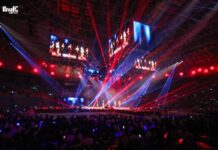
The National Folk Museum of Korea will build an open storage and information center in Paju, Gyeonggi-do Province, by 2020. Unlike existing museum storage, the new structure will be an open space for information where visitors can access exhibits, information, education and enjoy other museum-related experiences. The above shows a view of the new storage and information center.
Storages for museums or galleries are places where items for display are kept. These places used to remain closed to the general public. However, this is due to change in the near future thanks to the new storage and information center set to be built by the National Folk Museum of Korea in Heyri Art Valley of Paju, Gyeonggi-do Province, by 2020.
According to an announcement given by the museum on Dec. 20, the planned storage and information center is designed to make use of the owned articles through opening up access to the public, not just focusing on preserving the value and management of the items.
“It will be an open, visible repository, not just for preservation and maintenance, which aims to create a place for information sharing for visitors so that they can have access to exhibits, information, education, and experiences,” said a representative from the museum.

The National Folk Museum of Korea plans to build an open, visible storage and information center in Paju by 2020, hoping to maximize the openness and visibility of the place. According to the design plans, visitors will be able to actually view stored items inside exhibition rooms through the window of the lobby.
The idea of open storage goes beyond the notion of opening up facilities in a physical manner. It aims to create a living space which can connect the past and the present, not just keeping relics of the past. This can be clearly seen from the design plan by Shinhan Architects & Engineers. Titled “Time, an open storage where layers of time are formed,” the design plan was selected as the winner by the museum through an architecture plan contest. The concept of “time” in the plan is a single space in which people can observe both the past and the future of the Korean people, juxtaposed alongside one another. “Time” is not isolated in the past, according to the museum.
The design plan is divided into three sub-themes — “Walking Along Time,” “Facing Time” and “Protecting Time.” Under the detailed plan, a three-story building with one basement will be built on an area measuring 65,400 square meters. About half of the items owned by the museum will be moved to the new building when the construction is completed.
On the first floor, the museum will build exhibition halls, open storage, a discovery center for information searching and education, and a studio for preservation, science and research. On the second floor, a space for information sharing where exhibits, information and education can be combined will be created.
On the basement level, closed storage will be built which will focus more on the safe carrying and security of the owned relics.
Regarding the new storage and information center plan, the Director of the National Folk Museum of Korea Cheon Jingi said, “It will not just be an open space. It will rather be a space aimed to boost the participation of museum-goers so that they can watch stored relics and search for more related information.”
“It will be a new concept of museum support facilities which enable us to keep, display and research the owned items at the same time,” he added.
By Yoon Sojung
Korea.net Staff Writer
Images: National Folk Museum of Korea
arete@korea.kr























